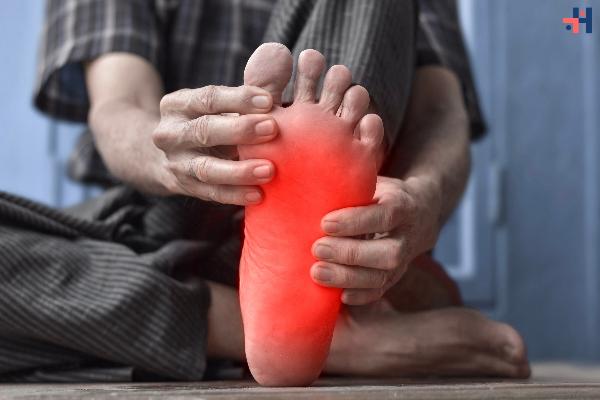Plantar Fasciitis: Symptoms, Causes, and Treatment

Strong 8k brings an ultra-HD IPTV experience to your living room and your pocket.
Plantar Fasciitis: Symptoms, Causes, and Treatment | Healthcare 360 Magazine
Plantar fasciitis is a common and often painful condition affecting the heel and bottom of the foot. This condition occurs when the plantar fascia, a thick band of tissue that runs across the bottom of your foot and connects your heel bone to your toes, becomes inflamed. Understanding the symptoms, causes, and treatment options for plantar fasciitis is crucial for managing and alleviating the pain associated with this condition.
What is Plantar Fasciitis?
The plantar fascia is a crucial component of your foot’s arch and provides support and stability during walking, running, and other activities. When this tissue becomes overstressed or strained, it can lead to small tears, inflammation, and ultimately, plantar fasciitis. This condition is one of the most common causes of heel pain.
Symptoms
Recognizing the symptoms of plantar fasciitis is the first step towards effective treatment and pain management. Here are the key symptoms to watch for:
Plantar Fasciitis: Symptoms, Causes, and Treatment | Healthcare 360 Magazine
Heel Pain
The most common symptom is a sharp, stabbing pain in the bottom of the heel. This pain is usually most intense with the first steps after waking up or after long periods of rest.
Pain After Exercise
While the pain may lessen during physical activity, it often returns with increased intensity after exercise or prolonged standing.
Stiffness and Tenderness
The bottom of the foot may feel stiff and tender, especially in the morning or after sitting for a while.
Swelling
In some cases, there may be mild swelling around the heel area.
Pain in the Arch
The pain may extend from the heel to the arch of the foot, creating discomfort throughout the bottom of the foot.
Causes and Risk Factors
Several factors can contribute to the development of plantar fasciitis. Understanding these can help in preventing and managing the condition.
Overuse
Activities that place a lot of stress on the heel and attached tissue, such as long-distance running, ballet, and aerobic dance, can contribute to the onset of plantar fasciitis.
Foot Mechanics
Flat feet, a high arch, or an abnormal walking pattern can affect the distribution of weight when you’re standing and put added stress on the plantar fascia.
Age
It is most common in people between the ages of 40 and 60.
Obesity
Excess weight puts extra stress on the plantar fascia.
Occupational Hazards
Jobs that require long hours of standing or walking on hard surfaces can increase the risk of developing plantar fasciitis.
Improper Footwear
Wearing shoes with poor arch support or soft soles can contribute to the strain on the plantar fascia.
Diagnosing:
If you suspect you have plantar fasciitis, it’s essential to seek a professional diagnosis. Healthcare providers typically diagnose the condition based on your medical history and a physical examination.
Physical Examination
Your doctor will check for areas of tenderness in your foot. The location of your pain can help determine its cause.
Imaging Tests
In some cases, your doctor may suggest X-rays or MRI to rule out other possible causes of heel pain, such as stress fractures or bone spurs.
Treatment Options
Treatment for plantar fasciitis focuses on relieving pain and inflammation, improving mobility, and preventing future occurrences. Here are several effective treatment options:
Plantar Fasciitis: Symptoms, Causes, and Treatment | Healthcare 360 Magazine
Rest and Ice
Resting your foot and applying ice can reduce inflammation and alleviate pain. Ice the affected area for 15-20 minutes several times a day.
Stretching Exercises
Stretching your calf muscles, Achilles tendon, and plantar fascia can help relieve pain and improve flexibility.
Orthotic Devices
Custom-made or over-the-counter orthotic devices can provide additional support to the arch of your foot and distribute pressure more evenly.
Physical Therapy
A physical therapist can design a specific exercise program to stretch and strengthen the plantar fascia, Achilles tendon, and lower leg muscles.
Medications
Nonsteroidal anti-inflammatory drugs (NSAIDs) such as ibuprofen or naproxen can help reduce pain and inflammation.
Night Splints
Wearing a night splint can help keep your foot in a stretched position overnight, reducing morning pain and stiffness.
Corticosteroid Injections
In severe cases, your doctor may recommend corticosteroid injections to reduce inflammation and relieve pain.
Extracorporeal Shock Wave Therapy (ESWT)
This non-invasive treatment uses sound waves to stimulate healing in the plantar fascia. It’s typically considered when other treatments have failed.
Surgery
In rare cases, surgical intervention may be necessary to release the tension on the plantar fascia. Surgery is usually considered only when other treatments have not provided relief after 6-12 months.
Prevention Strategies
Preventing plantar fasciitis involves taking steps to reduce stress on your feet and improve foot health. Here are some effective prevention strategies:
Plantar Fasciitis: Symptoms, Causes, and Treatment | Healthcare 360 Magazine
Maintain a Healthy Weight
Keeping your weight in check reduces stress on your plantar fascia.
Wear Supportive Footwear
Choose shoes with good arch support, proper cushioning, and a firm heel counter. Avoid wearing worn-out athletic shoes.
Replace Old Shoes
Regularly replace your athletic shoes to ensure they provide adequate support and cushioning.
Warm-Up and Stretch
Before engaging in physical activities, warm up properly and stretch your calves, Achilles tendon, and feet.
Modify Activities
If you experience pain, avoid activities that put excessive stress on your heels, such as running on hard surfaces. Opt for low-impact activities like swimming or cycling.
Strengthen Your Feet
Incorporate exercises that strengthen the muscles in your feet and lower legs to improve stability and support.
Use Orthotics
Consider using orthotic inserts in your shoes to provide additional support and prevent excessive strain on your plantar fascia.
Conclusion
Plantar fasciitis can be a debilitating condition, but with proper understanding and management, it is possible to alleviate the pain and prevent recurrence. By recognizing the symptoms early, understanding the risk factors, and following effective treatment and prevention strategies, you can keep your feet healthy and pain-free. If you suspect you have plantar fasciitis, consult a healthcare provider for a comprehensive diagnosis and personalized treatment plan. Taking proactive steps to care for your feet can make a significant difference in your overall well-being and quality of life.
References
American Academy of Orthopaedic Surgeons (AAOS)
Mayo Clinic
National Institute of Arthritis and Musculoskeletal and Skin Diseases (NIAMS)
By staying informed and proactive, you can manage plantar fasciitis effectively and maintain an active, healthy lifestyle. Take care of your feet, and they will take care of you.
Find practical solutions to common challenges through our insightful articles on Healthcare 360 Magazine
Note: IndiBlogHub features both user-submitted and editorial content. We do not verify third-party contributions. Read our Disclaimer and Privacy Policyfor details.







